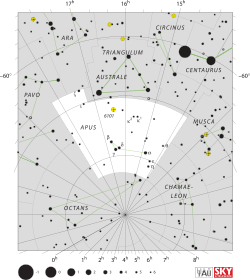Iota Apodis

| |
| Observation data Epoch J2000 Equinox J2000 | |
|---|---|
| Constellation | Apus |
| Right ascension | 17h 22m 05.87559s[1] |
| Declination | –70° 07′ 23.5400″[1] |
| Apparent magnitude (V) | 5.41[2] (5.90/6.46)[3] |
| Characteristics | |
| Spectral type | B9 V + B9.5 V[3] |
| U−B color index | –0.23[2] |
| B−V color index | –0.04[2] |
| Astrometry | |
| Radial velocity (Rv) | -4.3[4] km/s |
| Proper motion (μ) | RA: –1.94[1] mas/yr Dec.: –10.99[1] mas/yr |
| Parallax (π) | 2.47 ± 0.50[1] mas |
| Distance | approx. 1,300 ly (approx. 400 pc) |
| Other designations | |
Iota Apodis (ι Aps, ι Apodis) is the Bayer designation for a binary star[3] system in the southern circumpolar constellation of Apus. It is a faint target at an apparent visual magnitude of 5.41,[2] but still visible to the naked eye from suitably dark skies. The distance to this star can be roughly gauged from parallax measurements, yielding an estimate of 1,300 light-years (400 parsecs) with a 20% margin of error.[1]
Both stars are B-type main sequence stars, which indicates they shine with a blue-white hue.[6] The brighter component has a stellar classification of B9 V and an apparent magnitude 5.90, while the second member is a B9.5 V star with a magnitude of 6.46. The pair have an angular separation of 0.091 arcseconds[3] with a preliminary estimated orbital period of 51.441 years.[7] They are 3.89 ± 1.02 and 3.45 ± 0.90 times as massive as the Sun.[8]
Naming
In Chinese caused by adaptation of the European southern hemisphere constellations into the Chinese system, 異雀 (Yì Què), meaning Exotic Bird, refers to an asterism consisting of ι Apodis, ζ Apodis, β Apodis, γ Apodis, δ Octantis, δ1 Apodis, η Apodis, α Apodis and ε Apodis. Consequently, ι Apodis itself is known as 異雀二 (Yì Què èr, English: the Second Star of Exotic Bird.)[9]
References
- 1 2 3 4 5 6 van Leeuwen, F. (November 2007), "Validation of the new Hipparcos reduction", Astronomy and Astrophysics, 474 (2): 653–664, arXiv:0708.1752
 , Bibcode:2007A&A...474..653V, doi:10.1051/0004-6361:20078357.
, Bibcode:2007A&A...474..653V, doi:10.1051/0004-6361:20078357. - 1 2 3 4 Nicolet, B. (1978), "Photoelectric photometric Catalogue of homogeneous measurements in the UBV System", Astronomy and Astrophysics Supplement Series, 34: 1–49, Bibcode:1978A&AS...34....1N.
- 1 2 3 4 Eggleton, P. P.; Tokovinin, A. A. (September 2008), "A catalogue of multiplicity among bright stellar systems", Monthly Notices of the Royal Astronomical Society, 389 (2): 869–879, arXiv:0806.2878
 , Bibcode:2008MNRAS.389..869E, doi:10.1111/j.1365-2966.2008.13596.x.
, Bibcode:2008MNRAS.389..869E, doi:10.1111/j.1365-2966.2008.13596.x. - ↑ Wilson, Ralph Elmer (1953), General Catalogue of Stellar Radial Velocities, Washington: Carnegie Institution of Washington, Bibcode:1953GCRV..C......0W.
- ↑ "iot Aps -- Star", SIMBAD, Centre de Données astronomiques de Strasbourg, retrieved 2012-07-09.
- ↑ "The Colour of Stars", Australia Telescope, Outreach and Education, Commonwealth Scientific and Industrial Research Organisation, December 21, 2004, retrieved 2012-01-16
- ↑ Olević, D.; Cvetković, Z. (February 2004), "Orbits of 10 interferometric binary systems calculated by using the improved Koval'skij method", Astronomy and Astrophysics, 415: 259–264, Bibcode:2004A&A...415..259O, doi:10.1051/0004-6361:20034069.
- ↑ Docobo, J.A.; Andrade, M. (2013). "Dynamical and physical properties of 22 binaries discovered by W. S. Finsen". Monthly Notices of the Royal Astronomical Society. 428 (1): 321–39. Bibcode:2013MNRAS.428..321D. doi:10.1093/mnras/sts045.
- ↑ (Chinese) AEEA (Activities of Exhibition and Education in Astronomy) 天文教育資訊網 2006 年 7 月 29 日